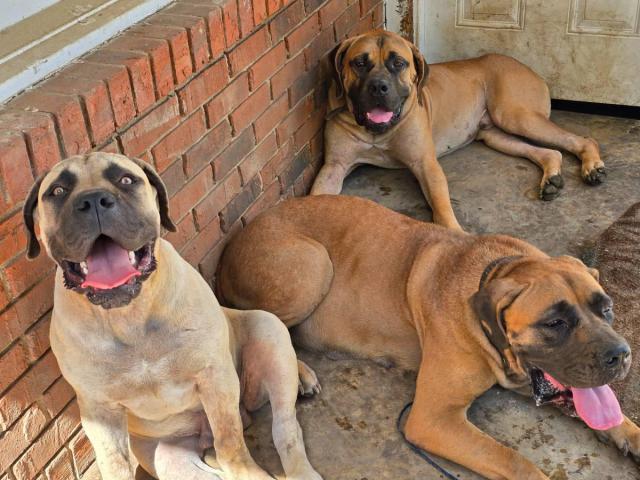Boerboel dog breed information
Boerboel: The Big-Hearted South African Guardian
A friendly, easy-to-read guide about history, temperament, care, and living with a Boerboel.
Quick snapshot
- Breed name: Boerboel (often pronounced "BOOR-bool")
- Origin: South Africa
- Size: Large to giant (males frequently 50–68+ kg / 110–150+ lbs)
- Temperament: Loyal, confident, protective, calm with family
- Best for: Experienced owners, families with secure yards, people who want a guardian companion
A short history
The Boerboel was developed by Dutch and Cape settlers in South Africa. Settlers crossed mastiff-type dogs with local dogs and other breeds to create a powerful, adaptable farm dog.
Boerboels guarded farms, protected families and livestock, and navigated the harsh African environment. Over time they became prized for strength, confidence, and loyalty.
What a Boerboel looks like
Boerboels are muscular, broad-chested, and solidly built. They look imposing but can move with surprising grace.
- Height: commonly 56–74 cm (22–29 in) at the shoulder
- Weight: commonly 45–68+ kg (100–150+ lbs)
- Coat: short, dense, smooth — low grooming needs
- Colors: brown, fawn, brindle, red, often with black masks
- Expression: alert, intelligent, confident
Temperament: calm but protective
Boerboels are often called "gentle giants." They bond deeply with their people, are calm at home, and naturally protective. They are not usually hypersocial with strangers, which is why early socialization and good training are essential.
- Loyal and family-oriented
- Protective — natural guardian instincts
- Confident, bold, and intelligent
- Independent thinkers — respond best to consistent leadership
Training and socialization — non-negotiable
Because Boerboels are strong, intelligent, and protective, training and socialization are mandatory for safe, happy ownership.
- Start early: expose puppies to people, places, sounds, and animals.
- Use positive reinforcement: treats, praise, and play work well.
- Be confident and consistent: stable leadership builds trust.
- Teach bite inhibition and impulse control: crucial for a strong dog.
- Enroll in classes: puppy or obedience classes help with socialization and structure.
Exercise and mental stimulation
Boerboels are not hyperactive sprinters, but they need daily physical activity and mental work.
- Aim for about 45–90 minutes of exercise daily depending on age and health.
- Mental enrichment: puzzle toys, scent games, tracking, obedience drills.
- Avoid high-impact exercise while growing — protect developing joints.
- Work that simulates a job (tracking, structured tasks) keeps them satisfied.
Living situation: what suits a Boerboel?
Boerboels adapt, but they thrive where their guardian role and exercise needs are respected.
- Yard: a secure, fenced yard is ideal.
- Apartment life: possible only with a heavy commitment to exercise and training.
- Family life: good with children when raised together and with supervision.
- Other pets: early socialization improves compatibility; careful introductions are a must.
Health and lifespan
Boerboels are generally healthy but share common large-breed risks:
- Hip and elbow dysplasia
- Heart conditions in some bloodlines
- Bloat (gastric torsion) — a serious emergency
- Possible eye problems (e.g., entropion)
- Average lifespan: about 9–11 years
Tips: pick a breeder who screens hips, elbows, and heart; keep the dog lean; feed high-quality large-breed diets; schedule regular vet checks.
Grooming and daily care
- Brush weekly — short coat, low shedding maintenance.
- Bathe only as needed to avoid drying the skin.
- Trim nails regularly; long nails are painful for heavy dogs.
- Check ears and teeth — brush teeth several times a week.
- Do regular skin checks (ticks, sores) — their short coat makes this easy.
Feeding and nutrition
Proper nutrition during growth and adulthood is important to prevent joint problems and obesity.
- Puppies: use a large-breed puppy formula to control growth rates.
- Adults: high-quality large/giant breed food; consider joint support supplements after consulting your vet.
- Avoid overfeeding — keep a lean body condition.
- Consult your veterinarian for portioning based on activity, age, and condition.
Choosing a Boerboel puppy or adult
Whether choosing a puppy or adopting an adult, prioritize temperament, health testing, and transparency.
- Reputable breeder: health testing (hips, elbows, heart), socialized puppies, documented pedigrees
- Rescue: breed rescues often have adults who are temperament-tested and rehomed responsibly
- Meet the parents: if possible, to judge size and temperament
Working roles and activities
Boerboels excel in guardian roles and can enjoy activities that use their brains and bodies:
- Family and property guardian
- Tracking, scent work, obedience
- Controlled protection sports with qualified trainers
Responsible ownership & legal notes
Because Boerboels are powerful guardian dogs, check local rules:
- Some jurisdictions have breed-specific legislation — check locally
- Insurance or rental agreements may restrict ownership
- Always keep the dog under control and socialized in public
Quick FAQ
- Are Boerboels aggressive?
- Not inherently. They are protective but can be stable and reliable with proper training and socialization.
- Do they drool a lot?
- Less than some mastiff breeds, but drooling varies by individual.
- How much do they cost?
- Prices vary widely. Budget also for food, vet care, training, and insurance.
- Can they live with other dogs?
- Often yes if socialized early; careful introductions are important.
Puppy checklist
- Crate and comfortable bed sized for a growing dog
- High-quality large-breed puppy food
- Sturdy leash and harness, ID tag
- Secure, puppy-proofed space and fenced yard
- Vet plan: vaccinations, microchip, deworming schedule
- Training plan and puppy class enrollment
- Safe chew toys and enrichment puzzles
